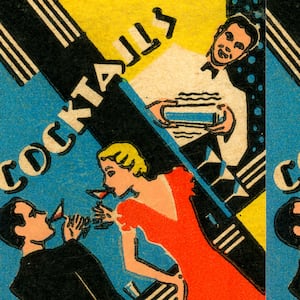We just had a Mother’s Day brunch at our son’s new apartment in Philly. I was sent to get a bottle of prosecco to make Bellinis, but there’d been a run on the bubbly wine at the local store. No problem. I instead grabbed two four-packs of Paulaner grapefruit radler. Once everyone had a taste, no urging was needed. The big half-liter beer cans disappeared quickly.
Radlers are a German type of fruit beer, but they’re not made by adding fruit to the brewing process. Instead, in the same way Germans make new words by putting existing terms together, in this case, fruit juice-based soft drinks are combined with lighter, non-hoppy beer, like helles or hefeweizen.
The common origin story for these concoctions you’ll get is that radlers were “invented” in 1922 by an innkeeper named Franz Xavier Kugler in Deisenhofen, just outside Munich. He had a beer garden called the Kugler-Alm that was on a bike trail from Munich. (Some say Kugler built the bike trail from Munich to his beer garden.)
ADVERTISEMENT
One hot day in June, some 13,000 thirsty cyclists arrived at the Kugler-Alm. So as you can imagine Kugler started to run out of beer and in a flash of inspiration, began to mix it with lemon soda, in a 50/50 ratio. He served it to the cyclists—radler is Bavarian idiom for “cyclist” —and this so-called radlermass (“cyclist’s liter”) became popular.
Amateur word sleuths will note the telltale signs of bullshit here. There is an unusual amount of detail for a word origin: the innkeeper’s full name, the exact month and location of the “invention,” and even the original formula of beer to soda. Add into that the laughable idea that thousands of German cyclists would happily acquiesce to their beer being unexpectedly cut with lemonade or that a German who went to the expense of building a bike trail specifically to bring cyclists to his beer garden would actually run out of beer on a summer day...It’s no wonder that many suspect that Kugler himself spread the story as a sales pitch.
In fact, a memoir by Lena Christ, a writer who worked in a Munich restaurant in 1900 and 1901, notes not only was beer served, but also all kinds of lemonades, carbonated water, schorlemorle (wine mixed with sparkling water or apple juice) and radlermasse. The memoir, Erinnerungen einer Überflüssigen (Remembrances of an Unwanted One), was published in 1912, which clearly predates Kugler’s 1922 claim. She gives no explanation of radlermasse (the plural of radlermass), which certainly indicates that she was sure her readers would know this drink.
I’d heard of radlers, but always as something they did in Germany. It was also something that didn’t appeal to me.
That is until a fiercely hot night eight years ago in southern Alberta, when I had my first Stiegl Radler. I’d spent the day at the Black Velvet distillery, and after dinner I went out with some of the brand’s crew for beers. The taproom was jumping and had no air-conditioning, so cold beer was the way to go. The brand manager got a glass full of some hazy, pale yellow-white beverage. “It’s Stiegl,” she said. “Grapefruit beer. You should try it!”
The grapefruit aroma was apparent, but so was the beer—I could smell clean malt, not just fruit. The first sip sold me. It was cold, of course, but there was a tart and refreshing grapefruit burst, along with a clean, smooth lager beer experience. I drank Stiegl the rest of the night, and the 2.0 percent ABV was a pleasant bonus. I felt great the next morning!
Fast forward to 2021 and the radler is having a moment, a moment that’s turning into momentum. Stiegl’s boldly colorful cans have spread, and the sales have lured breweries like Schöfferhoffer, Ottakringer, and even some big, recognizable names like Paulaner and Bitburger to test the radler waters in America.
Is a radler the same thing as a shandy, as the British call the blend of beer and ginger ale that’s grown in popularity, particularly in the Caribbean?
“It’s six of one, half a dozen of the other,” says Fran Cattani, who imports the Ottakringer Radlers from Vienna for S&H Imports. “Shandy is soda and a beer, radler is more like a lemon soda, or lemonade, and beer.” Radlers are most often citrus-based, but Stiegl’s bringing a raspberry radler, and Schöfferhoffer has introduced a new passion fruit version. I also tend to think of a shandy as soda and beer, as opposed to a radler, which I think of as beer and soda. A thin difference, maybe, but it means something to me.
The name’s an important thing, though, because the association with cyclists, sports and an active life is appropriate. The 50/50 split with beer and lemonade leads to a drink that’s ideal for integration into that life style. Radlers range from 1.8 to 2.5 percent alcohol by volume, less than the usual light beer, and the “lemonade” is usually a carbonated soft drink based on natural fruit juices with a minimal amount of added sugar.
This means that a “radler” is a drink a cyclist can have and then hop right back on their bike to pedal off to the next bar. Not recommended for a big glass of imperial IPA, helpful advice that I can offer from my personal experience.
Eric Kobus is the regional manager for Glunz Imports in Chicago, where they’ve been selling Stiegl for more than ten years, and he finds the appreciation for the low alcohol somewhat amusing. “Early on,” he said, “when you were talking about radlers, you were almost apologetic because of the low alcohol. Now, it’s the point of it. You can play golf, go for a run, whatever. It’s become the main selling point.”
And if you want, you can “pick it up.” I learned that concept from Daniel Leeman, who works with Stiegl importer Global Beer Network in Massachusetts. “I was at the Erin Rose in New Orleans, and I see they have Stiegl, great!” he told me. “I order one, and the bartender asks, ‘Do you want me to pick that up?’ What? ‘A shot with it. Vodka or tequila?’ It’s only 2 percent, so I guess in New Orleans, they figure you must want more booze! There’s a place in Chicago called Happy Camper, they put a shot of spirits right in the can, tuck a cocktail umbrella in the hole, and serve it as a cocktail. You can take it light and low, if that’s what you want, or you can pick it up.”
Picked up or not, Stiegl grapefruit is still the biggest selling radler in the U.S. by quite a bit, according to numbers from industry datamonger IRI, followed in the rankings by their Zitrone lemon radler, and two relatively new entries: Paulaner’s grapefruit and Bitburger’s more traditional lemonade radler. Schöfferhoffer is hefeweizen-based, and surging in my local market of Pennsylvania; you see their grapefruit everywhere. Ottakringer has just entered the market with a foursome of citrus flavors: grapefruit, lemon, orange and lime. Kobus said Glunz is bringing in peach and lemon radlers this summer from Egger, another Austrian brewer.
The numbers are still small, but the growth rates are impressive; Bitburger’s lemon radler, for instance, is up 104 percent over the past 12 months.
Steve Hauser, the CEO of Paulaner USA, touched on something that I think has a lot to do with why radlers have caught on. “It’s all occasion-based, so the consumer who was drinking a malt-based seltzer might look at a radler, a true beer-based fruit infusion.”
Did the interest in radlers come from the interest in hard seltzers? I don’t know, but I can tell you that I don’t really find seltzers appealing—hard or not—largely because of the mere teasing wisp of flavoring. I’m much more interested in a low-sugar fruit juice-based drink, like the Italian San Pellegrino soft drinks or the Bravazzi line of hard sodas, and radlers slot right into that.
Whatever the reason for their sudden popularity and whenever they were invented, radlers are having their moment in America. So, next time you’ve got a thirst for something different, give one a spin.






